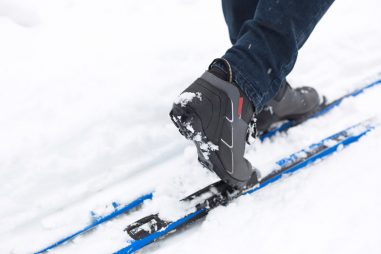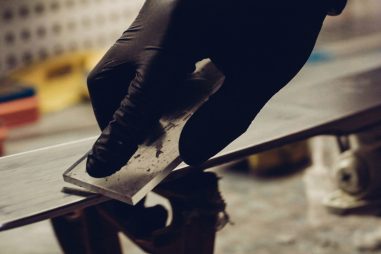One of the most important decisions you’ll have to make in cross country skiing is choosing what type of ski to use. Waxed and waxless skis both have their advantages and disadvantages. But you really can’t go wrong with either.
To help you choose, you first need to understand how they work, the importance of waxing, and when and how to wax them. So read on to find out more.
What Are the Two Main Types of Cross Country Skiing?
The two main types of cross country skiing are classic and skate. While they’re both done on groomed tracks, some of the gear is different. They also employ different techniques.
When it comes to movements, classic cross country is more similar to walking or running on skis. Meanwhile, the skate technique is like ice skating or rollerblading.
What Is a Waxless Cross Country Ski?
Waxless skis have a grip zone at the bottom. This grip zone (also known as a kick zone), is what allows your skis to grip the snow and give you traction as you move. They often come in the form of a textured pattern or a strip of climbing skin.
With this ski type, you don’t need to apply a grip wax to get traction. It’s the more convenient and low-maintenance option compared to waxable skis. This is why it’s a popular choice among cross country skiers.
How Do Waxless Cross Country Skis Work?
Waxless skis have a textured pattern that allows them to grip the snow. And that’s essential for uphill climbs or maintaining your momentum on flat terrain. The pattern designs vary, but the most common are the following:
- Fishscale: has a scale pattern throughout the bottom.
- Skin: a fuzzy material at the base.
- Zero: a sandpaper-like material.
Are All Cross Country Skis Waxless?
Not all cross country skis are waxless. There are waxable skis where you apply a grip wax on the kick zone to create grip and traction. Even waxless have parts that need to be waxed.
How Do I Know if My Cross Country Skis Are Waxless?
You’ll know your ski is waxless if there is a textured pattern at the ski’s bottom, underneath where the bindings should be. They come in different textures which makes it possible to grip the snow. If it’s smooth and bare, it’s a waxable ski.
Are Waxless Cross Country Skis Any Good?
Waxless skis are great to use and it’s one of the reasons why they’re popular. It’s also more convenient since you don’t have to apply grip wax before skiing.
With waxless skis, you get a good balance between grip and glide. You have enough grip to create traction and glide when needed so you can maintain your forward momentum. They also work well with a variety of snow conditions, another reason why they’re pretty good.
Can You Wax Waxless Cross Country Skis?
Waxless skis are a little deceiving. While they’re designed to perform well even without adding grip wax on the kick zone, you still need to apply wax on the other parts.
As for the kick zone, you can still apply wax on that area if you want to. Doing so gives you additional traction and glide. It can also decrease wear and tear and increase longevity.
Do You Need to Wax Waxless Cross Country Skis?
You don’t need to wax the kick zone of waxless skis. They’ll perform well without wax, as by design.
However, you need to wax the tail and the tips, also known as the glide zone. There are untextured areas where you need to apply glide wax. This will help you glide properly and easily. Without it, you can experience too much friction and you’ll have to exert a lot of effort just to get moving.
What Are Fish Scales on Cross Country Skis?
Fish scales on cross country skis refer to the textured pattern on the bottom of the ski. You’ll find it in the kick zone, below the binding. They’re called fish scales because of their similar pattern to that of fish scales.
How Do You Wax Fishscale Cross Country Skis?
Typically you don’t need to wax the fish scale itself. The texture alone is enough to provide grip. However, it’s recommended to wax the tip and the tail sections. But instead of using grip wax, you apply glide wax instead. Since you already have the fish scales that provide the grip, the glide wax on the tips and tails assist in giving you a smoother ride when gliding.
Do You Need to Wax Cross Country Skis?
Cross country skis need to be waxed but the wax used will be different depending on the part of the ski.
For waxable cross country skis, you need to put kick wax on the kick zone and glide wax on the tips and tails.
For waxless cross country skis, kick wax is optional on the kick zone but you need to put glide wax on the tips and tails.
Do New Cross Country Skis Need Wax?
If your new pair are waxable skis, then you should need to wax them before use.
For waxless skis, you should apply glide wax on the tips and the tails. As for the kick zone, some skiers still recommend applying kick wax even if your skis are new. You don’t know how long the skis have been sitting in the shop, causing the wax to dry out.
How Do You Wax New Cross Country Skis?
If you choose to wax brand new skis, the process is no different from waxing used or old skis. However, some recommend roughening the kick zone of brand new skis with sandpaper.
As for the waxing process itself, there are three basic steps:
- Cleaning the Base: Using a brush, you remove the dirt and dried snow stuck on your ski. This ensures the base is smooth and clean for the wax to stick properly. Brush towards one direction only, ideally from the tip to the tail.
- Applying the Wax: For this step, you need a waxing iron to melt and apply the wax on the ski base. It also lets you regulate the wax temperature depending on the wax you’re using. Once your wax is hot enough, let it drip on the base. Then use the iron to spread it out evenly.
- Brushing and Scraping the Base: Once the wax has cooled down to room temperature, you need to scrape off the excess wax.
Do Old Cross Country Skis Need Wax?
As long as your skis are still intact and still in good condition, they still need to be waxed. Once the wax has diminished, you’ll need to apply a new layer.
One way to tell when to wax is if there’s discoloration at the base of your ski. It’ll look chalky, white, and dry. You can also tell when your ski’s not performing as well as it should. A good waxing should be able to get you back on track.
Do All Cross Country Skis Have Scales?
Only waxless cross country skis have scales. Also called fish scales, the textured pattern on the kick zone allows the ski to grip the snow.
Do You Wax the Scales on Cross Country Skis?
You don’t need to wax the scales on waxless cross country skis. The pattern and texture are enough to grip the snow. Though some skiers still put a thin layer of kick wax to preserve the texture. But because of the pattern, it can be difficult to remove old wax. So proceed with caution.
How Often Should You Wax Cross Country Skis?
How often you wax your skis depends on how much you ski. Snow conditions can also affect your wax. Assuming you’re skiing during the winter season, regular skiers need to wax their skis every 3 to 5 days. If you’re a seasonal skier, be sure to wax each time before you ride.
How Do I Know if I Need to Wax My Cross Country Skis?
There are several ways to know when it’s time to wax your cross country skis. First, skis will dry out easily if kept in storage for a while. So if you only ski during the winter, you need to wax before use.
Second, if you notice a dip in your ski’s performance and you’re not going as fast as usual, it may be time to apply wax. This may start happening after 2 days of constant skiing.
Third, check your ski base. If the wax has become discolored, dusty, or chalky, it’s definitely time to wax up.
What Kind of Wax Do You Use for Cross Country Skis?
The kind of wax you use depends on the type of cross country ski you have. For waxable skis, you need a kick wax and a glide wax. For waxless skis, you only need a glide wax.
The kick wax is applied under your ski, in the same area as your bindings. It provides the grip required to gain traction and prevent you from slipping. The glide wax is applied at the tips and tails. This ensures you can glide smoothly each time.
Does Cross Country Ski Wax Go Bad?
Cross country skis don’t go bad or expire as they don’t contain any perishable ingredients.
How Long Does Cross Country Ski Wax Last?
Typically, each application will last about 20 miles. Yet you have to factor in how fast or aggressive you are. You also need to consider the terrain and snow conditions. You can end up waxing 4 to 5 times each time you ski.
How Do You Clean Cross Country Skis Before Waxing?
You can clean your cross country ski using different tools. To clean the kick zone and remove any dirt and debris, you’ll need a paper towel. Meanwhile, you need a steel or bronze brush for the tips and the tails. A steel brush is more appropriate if there’s a lot of dirt, debris, and old wax on the base. For less dirty skis, a bronze brush will do.
Aside from a brush, you can also use a liquid ski cleaner. It removes dirt, grime, and thin wax layers.
How Do You Remove Old Wax From Cross Country Skis?
You can remove old wax using a plastic scraper, a brush, and a wax remover. Removing old wax is critical before waxing your skis. Dirt and debris can get stuck with old wax and prevent you from applying a fresh layer evenly. It can also prevent your ski from performing as well as it should.
What Takes Wax Off Cross Country Skis?
How you take off wax differs for the kick and glide waxes. Before removing old wax, be sure to wipe away any loose dirt using a paper towel. Once done, use a plastic scraper to remove old wax. But keep in mind not to press too hard since it can damage your ski. Scrape with a downward motion to move the wax away from the clean part.
Once done, here’s how you can take wax off cross country skis:
- Kick Wax: Use a high-quality wax remover solution. Pour the product on a paper towel and wipe the remaining wax.
- Glide Wax: Use a brush to remove the remaining wax.
How to Wax Cross Country Skis Without Iron
There are two ways for you to wax your skis without an iron. The first is to use liquid ski wax. It’s the easiest and most convenient method to use. Once your skis are clean, you just basically spray on the wax on your skis.
The second method is to use a roto wool brush. Equipped with the right tools, you apply the wax on the brush as it rotates. You then apply the wax on your skis using the roto wool.







